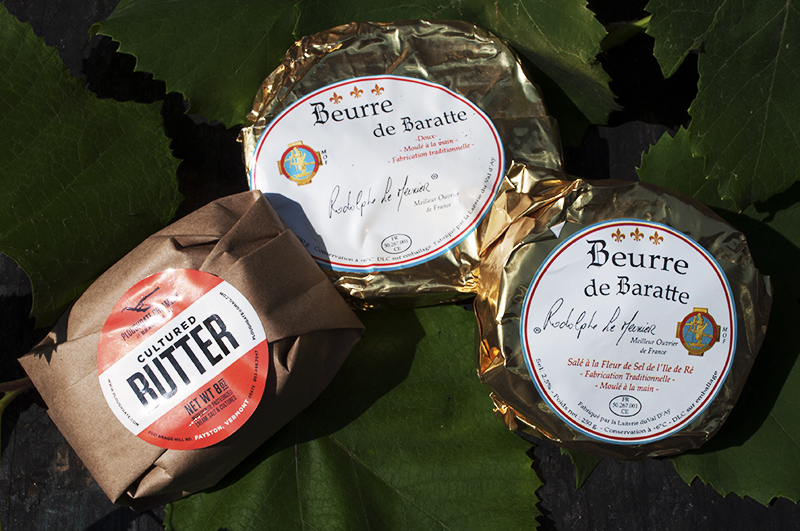
Two of our favorite cultured butters: long-time obsession Rodolphe Le Meunier's Beurre de Baratte (salted and sweet), and local newcomer Ploughgate Creamery's salted butter.
Many years ago, when I was a young child, I would never have thought that I would be writing about butter. Growing up in the southeastern part of Turkey, we would visit my grandmother and aunt who lived in a village close to the town I was raised in prior to my relocation to the US. Those trips are some of the fondest memories I have from growing up. We would always be eating really well and enjoying ourselves away from the city. My grandmother had two cows living on her farm and the milk would get used in a variety of different ways, from clotted cream to yogurt, but my favorite milk product that she made was butter. Early in the morning she would wake up, fill a wooden churn and start churning. She would do this for hours until the cream started to solidify into a smooth creamy butter. We thoroughly enjoyed having this with warm, wood-fired bread and grape molasses, along with many other fresh village delicacies.
All those times watching my grandmother make butter, I never thought that deeply about what butter is. In its simplest explanation, butter is solidified cream. Butterfat has the tendency to adhere to each other. During the churning process the butterfat in the cream starts to solidify. During this solidification process, the fat globules start to stick to each other and they get bigger and bigger until most of the fat turns into one solid mass. Think of tiny Play-Doh pieces being shaken in a box, what happens to the Play-Doh? It will stick to each other until all of the tiny pieces make a whole.
Bon Appetit magazine recently featured some of their favorite, and our favorite, cultured butters. What is cultured butter you may ask? In France and many other parts of Europe, cultures are added to the cream prior to churning, and then the cream sits for a few hours or up to three days. Specific cultures are added to develop aroma, flavor, and texture. Certain cultures can result in an acidic butter while others may produce a more nutty counterpart. Live bacteria or cultures may not sound appetizing but it is a crucial step in making cultured butter, and give the butter maker an extra tool to develop their own ideal flavor profile. For a butter to be considered cultured, it must also have a fat content of at least 82%. When it comes to dairy products, in my opinion, the higher the fat content the better!
We have a number of different cultured butters here at our Cambridge shop, including the ones featured in Bon Appetit last month. These are all exceptional butters and we are happy to see them getting the broader attention they deserve. The first one on the list, Rodolphe Le Meunier, has been a long time favorite here at the shop. A cultured French butter made using fresh Normandy cream, this butter is churned in the traditional French method, hand-molded, and then wrapped in a gold foil. We currently carry two varieties, a sweet butter (Doux) or one that is sprinkled with French sea salt (Salé à la Fleur de Sel). We are also thrilled to see new, New England-based Marisa Mauro’s Ploughgate Creamery cultured butter on Bon Appetit's list. We especially love this butter, not just because it’s delicious, but because we have a close relationship with the maker herself. Marisa was a cheese maker prior to starting her butter business and a dear friend of the shop. Marisa makes her butter in Vermont at Bragg Farm using fresh cream sourced from the St. Albans Coop. She cultures her cream for 48 hours which results in a nutty, sweet butter and we absolutely love it! The sea salt crystals she adds also compliment the butter, giving you periodic bursts of saltiness.
These are some of our favorite snacking butters. Overindulging may not always be the best, but whether it’s baking, cooking or just slathering some on a hot piece of toast, we love butter's ability to transform anything into something so much more. Check out the rest of our butter selection, or make room for one of these remarkable cultured butters on your table.
Serdar Sinaci is a buyer and food and drink enthusiast at Formaggio Kitchen Cambridge.

